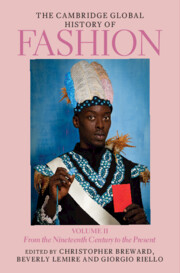Book contents
- The Cambridge Global History of Fashion
- The Cambridge Global History of Fashion
- The Cambridge Global History of Fashion
- Copyright page
- Contents for Volume II
- Figures for Volume II
- Maps for Volume II
- Table for Volume II
- Contributors for Volume II
- Preface
- Part IV Fashion, Modernism, and Modernity
- 21 Fashionable Masculinities in England and Beyond
- 22 Fashion in Capitalism
- 23 Fashion and Youth in Western Societies
- 24 Fashion and Time in China’s Twentieth Century
- 25 The Totalitarian State and Fashion in the Twentieth Century
- 26 Hollywood and Beyond
- 27 Fashion and Non-Fashion Cultures
- 28 Fashion and Hypermodernity
- Part V Fashion, Colonialism, and Post-Colonialism
- Part VI Fashion Systems and Globalization
- Index
- References
23 - Fashion and Youth in Western Societies
Street Style and Race, c. 1830–1940
from Part IV - Fashion, Modernism, and Modernity
Published online by Cambridge University Press: 04 August 2023
- The Cambridge Global History of Fashion
- The Cambridge Global History of Fashion
- The Cambridge Global History of Fashion
- Copyright page
- Contents for Volume II
- Figures for Volume II
- Maps for Volume II
- Table for Volume II
- Contributors for Volume II
- Preface
- Part IV Fashion, Modernism, and Modernity
- 21 Fashionable Masculinities in England and Beyond
- 22 Fashion in Capitalism
- 23 Fashion and Youth in Western Societies
- 24 Fashion and Time in China’s Twentieth Century
- 25 The Totalitarian State and Fashion in the Twentieth Century
- 26 Hollywood and Beyond
- 27 Fashion and Non-Fashion Cultures
- 28 Fashion and Hypermodernity
- Part V Fashion, Colonialism, and Post-Colonialism
- Part VI Fashion Systems and Globalization
- Index
- References
Summary
Abram Dayton was unequivocal that, in the 1830s, the Bowery Boys (or B’hoys) of his native New York consciously adopted a distinct dress style, quite different from that of ‘the centre of fashion’, Broadway. Named for the street over which they reigned in lower Manhattan’s Five Points neighbourhood – ‘a hell-mouth of infamy and woe’ – the Bowery Boys were labouring men, many of them apprentices, who took great pride in their appearance. Nineteenth-century cities teemed with young people and the Bowery Boys are but one group of urban youths that, lacking the personal or vicarious status symbols of elite peers – money, profession, property, family pedigree – used distinctive dress and transgressive behaviour to challenge and differentiate themselves from the mainstream, express identity, assert agency, and show group allegiance. And while a uniform dress style potentially erodes individual identity, for many of the young people discussed in this chapter, personal identity was centred on membership of a particular group and the visual advertisement of this through adoption of the group’s dress style.
- Type
- Chapter
- Information
- The Cambridge Global History of FashionFrom the Nineteenth Century to the Present, pp. 801 - 837Publisher: Cambridge University PressPrint publication year: 2023



